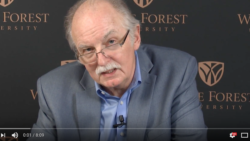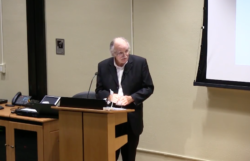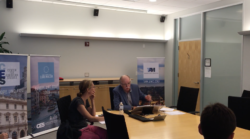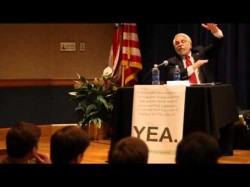Cataloging Weaknesses in the State of the Union Address
So, the State of the Union is strong, is it? Well, maybe it is for the people the President chose to speak about last night. But what about the ones he only mentioned in passing, or the ones that he omitted to mention at all? What about the state of the union for those Americans in, or on the edge of, poverty? What about the state of the union for those in the process, or on the edge, of losing their homes; or for those young working families trying to combine low-paid work, full-time child-care and inadequate child support? Is the state of the union fine for them? No, it is not.
Catalog speeches are never the best, and this State of the Union Address, like so many before it, was very much a catalog. Here we had a President, elected with a clear majority, with an opportunity to lay out a clear vision and a clear philosophy for the country to follow. And there were moments in the speech when vision and philosophy briefly surfaced: when a general defense of smart government was on offer, and when an appeal to unite around modest agreed reforms was strongly pushed. But mainly the Address was a catalog of things he wanted Congress to do – mostly things to do which we had heard about before – with some pretty pedestrian linkages taking us from one desired thing to another. True, the Address was vaguely populist in tone, and no doubt offensive to Tea Party Republicans for that reason; and we did hear briefly – really for the first time in this President’s State of the Union Addresses – about problems of poverty, about problems of gender discrimination in pay; and about the need for a significant increase in the minimum wage and the future index-linking of that minimum wage to the cost of living. All that was good to hear.
But mainly what we got from the President last night, even in the most populist moments of the Address, were superficial proposals that at best could only scrape the surface of problems so deeply embedded in our society that their solution clearly requires root-and-branch reform. It was not so much that problems were ignored in the Address. It was rather that the solutions offered to them were sufficiently modest as to seem at times almost derisible.
- Take for example the President last night on the issue of poverty. He did mention it. That was something new and welcome. He talked of “communities in this country where no matter how hard you work, it’s virtually impossible to get ahead. Factory towns decimated from years of plants packing up. Inescapable pockets of poverty, urban and rural, where young adults are still fighting for their first job.” And he offered a solution of a sort: what he called “new ladders of opportunity into the middle class for all who are willing to climb them” to be created by new public-private partnerships in 20 of America’s hardest-hit towns. But does that solution in any way address the scale of the problem. No, it does not.
- Then there was the question of low wages. Here the President’s sentiments were clear and progressive. He was offended that: “today, a full-time worker making the minimum wage earns $14,500 a year. Even with the tax relief we’ve put in place, a family with two kids that earns the minimum wage still lives below the poverty line.” He was also offended “when our wives, mothers and daughters” meet “discrimination in the workplace and… fear domestic violence.” His solution: raising and indexing the minimum wage, and having Congress pass both the Violence Against Women Act and the Paycheck Fairness Act. That was and is a vital start, but it is hardly a finish.
- And finally, the old-chestnut of housing and foreclosures: on this the President seemed to think the problem was rapidly vanishing. “Today,” he told Congress, “our housing market is finally healing from the collapse of 2007. Home prices are rising at the fastest pace in six years, home purchases are up nearly 50 percent, and construction is expanding again.” Fortunately he did recognize that “even with mortgage rates near a 50-year low, too many families with solid credit who want to buy a home are being rejected. Too many families who have never missed a payment and want to refinance are being told no;” but he seemed to think that a bill currently before Congress “that would give every responsible homeowner in America the chance to save $3,000 a year by refinancing at today’s rates” was an adequate policy response to any housing problem that is left. But it is not.
Why are these policy responses inadequate? They are inadequate because of the scale of the problems they address but fail to match.
- Poverty. At the last count by the Census Bureau (December 2012) the official poverty rate across the United States as a whole remained stuck in 2011 – unchanged from 2010 at 46.2 million. That is 15% of the entire U.S. population: more than one American in seven. ‘The poverty rate in 2011 for children under age 18 was 21.9 percent:”[1] more than one American child in five. For African-Americans, the poverty rate was 27.6 percent – nearly 11 million people. For Hispanic Americans, the poverty rate was 13.2 million – over 13 million people. And those numbers could well have been higher if the way we measure poverty was not so outdated;[2] if now-threatened programs like the Supplemental Nutrition Assistance Program hadn’t kept many millions more out of poverty;[3] and if more than one million people – mainly young, male and disproportionately African-American – were not locked away in a jail population that exceeds any other in the advanced industrial world.[4] With more than 20 million Americans surviving on less than half the poverty level,[5] and 17 million children currently in households that are officially food-insecure,[6] there is one thing of which we can be certain: there is no strong state of the union for those Americans even if there is a strong union for others! And the second thing of which we can be certain is that guaranteeing pre-school places to all of those food-insecure children, however desirable that may be, will not by that act alone transform their poverty.
- Low Wages. There is a lot of low pay in the contemporary American economy, indeed more now even than before. On the latest data, “the number of low-income working families increased to 10.4 million in 2011, up from 10.2 million a year earlier.”[7] That means over 47 million Americans living in families – nearly a third of all working families – where week-by-week they “may not have enough money to meet basic needs.” Why? Because although many in those families are returning to work, “they are often taking jobs with lower wages and less job security, compared with the middle-class jobs they held before the economic downturn.” As the Working Poor Families Project Policy Brief puts it, “these low-wage jobs typically offer limited opportunities for advancement, few (if any) benefits, and create challenges for parents trying to balance work and family responsibilities.”[8] Even manufacturing employment – much sought after as a solution to unemployment by this Administration – does not currently pay what once it did. Manufacturing wages are down in an economy denuded of trade unions, and subject to growing and significant income and wealth inequalities.[9] Right-wing commentators may deny the reality of a stagnant middle class,[10] but they are wrong.[11] Right now almost half the adult population – 44 percent of all Americans – quite simply “don’t have enough savings or other liquid assets to stay out of poverty for more than three months”[12] if they lose their jobs. Their state of the union isn’t strong. At the very best, it is deeply insecure and financially pressed. A better minimum wage will help, but strong trade unions and access to cheap adequate child-care would help more.
- Foreclosures. True, the volume of foreclosures is down this year on last year: but only from the 3.9 million a year in 2010 & 2011 to a projected 2.3 million in 2012. America has seen more than 17.2 million foreclosures and 5 million home-repossessions since 2007, the bulk of them on the President’s watch.[13] As the remarkable paper by Dan Immergluck has recently documented so fully, foreclosure prevention measures under this Administration can and should be seriously faulted: “for being too reliant on marginal incentive payments, for failing to provide a key policy, bankruptcy modification, which would have encouraged lenders to modify loans more aggressively, and for not sanctioning servicers more aggressively for poor performance or noncompliance.”[14] This is an Administration that is concerned about the unemployed, but it is also an Administration “too captive to the policy preferences of the financial services industry” to act directly to help the “fully 42 percent of the foreclosed” who “reported that members of their household had lost jobs in the past two years.”[15] There is an irony and a sadness in the fact that the unprecedented presence of an African-American family in the White House should have coincided with a recession and foreclosure crisis that has entirely obliterated the wealth of at least a third of all black households. That foreclosure crisis has hit all sections of middle-America, of course, but it has hit Hispanic and African-American households more heavily than others:[16] and yet still this Administration tinkers with the housing market only on its edge. Be in no doubt, a bill to facilitate refinancing will not cut it when the loss of wealth has already been this severe.
As I listened to the Address last night, I could not help thinking of the contrast between what we can do militarily and what we choose to socially. It is a remarkable feature of our modern condition that we possess (and apparently regularly use) a military technology that can locate, identify and destroy an al Qaeda operative living in the midst of crowds thousands of miles away; at the very time when many of our political leaders seem incapable of locating – let along attacking – the mass poverty that is staring them in the face every time they go outside their office door. After all Washington DC is not just the nation’s capital. It’s also home to 630,000 people, half of whom are African-American and one in five of whom is actually officially poor! That’s a higher poverty rate for the capital city of a Union that is apparently strong than for any state in that Union other than Mississippi. To politicians blind to the inequalities which surround us, the state of the union may look great inside the beltway, at least if you’re not one of the 19% of Washington DC’s residents who are struggling with low pay or unemployment.[17] But please, can we stop pretending that it is possible to be genuinely progressive in modern America without making the alleviation of poverty our absolute top priority. And can we stop pretending too that if we create “ladders into the middle class,” the problem of poverty will somehow vanish. It will not. Ladders only help people leave poverty behind. They don’t remove poverty; they simply enable a favored few to escape from it. Societies only remove poverty by eradicating it – by raising the floor for everyone – and that eradication, and thereby the creation of a genuinely strong union, requires policies that are far more radical than any that surfaced in last night’s Address.
Last night there was poverty aplenty in the state of the union: poverty in policy and vision in Washington, to match the poverty of so many of our neighbors in the rest of America. Last night was an opportunity lost.
[1] US Census Bureau, Income, Poverty and Health Insurance Coverage in the United States 2011, available at http://www.census.gov/newsroom/releases/archives/income_wealth/cb12-172.html
[2] On the Bureau’s own updated figures, the total in 2011 would be 49.7 million. On this, see Ben Casselman, “Alternative Measure Sees More People Living in Poverty,” The Wall Street Journal, November 14, 2012: available at http://blogs.wsj.com/economics/2012/11/14/alternative-measure-sees-more-people-living-in-poverty/
[3] Take those programs away, and the poverty rate would rise to a staggering 28.6%; See https://twitter.com/CenterOnBudget/status/299220140418015233
[4] See One in 100: Behind Bars in America 2008: available at www.pewtrusts.org/uploadedFiles/…/Reports/…/one_in_100.pdf
[5] Peter Edelman, “The State of Poverty in America,” The American Prospect, June 22, 2012: available at http://prospect.org/article/state-poverty-america
[6] Joel Berg, How President Obama Can Reverse America’s Worsening Hunger Metrics, Center for American Progress, February 4, 2013: available at http://www.americanprogress.org/issues/poverty/report/2013/02/04/51178/how-president-obama-can-reverse-americas-worsening-hunger-metrics/
[7] The Working Poor Families Project, Low-Income Working Families: The Growing Economic Gap, Policy Brief, winter 2012-13: available at http://www.workingpoorfamilies.org/
[8] Ibid.
[9] Jim Tankersley, “Manufacturing jobs used to pay well. Not anymore,” The Washington Post, January 17, 2013: available at http://www.highbeam.com/doc/1P2-34132167.html
[10] Donald Boudreaux and Mark Perry, ‘The Myth of a Stagnant Middle Class,” The Wall Street Journal, January 23, 2013: available at http://online.wsj.com/article/SB10001424127887323468604578249723138161566.html
[11] Neil Irwin, ‘Yes, the middle class really is falling behind,” The Washington Post, January 24, 2013: available at http://groups.yahoo.com/group/DemocraticLeft/message/45794
[12] Pam Fessler, Study: Nearly Half In U.S. Lack Financial Safety Net, NPR January 30, 2013: available at http://www.npr.org/2013/01/30/170561872/study-nearly-half-in-u-s-lack-financial-safety-net
[14] Dan Immergluck, “Too Little, Too Late, and Too Timid: The Federal Response to the Foreclosure Crisis at the Five Year Mark,” Housing Policy Debate, 2012: available at http://papers.ssrn.com/sol3/papers.cfm?abstract_id=1930686
The Immergluck paper has the number of foreclosures on the Obama watch lower, at 5.3 million.
[15] Christopher Niedt and Isaac William Martin, “Who are the foreclosed? A statistical Portrait of America in Crisis,” Housing Policy Debate, December 2012: available at www.hofstra.edu/Faculty/fac_profiles.cfm?id=1087
[16] The net worth of black households fell by 53% between 2005 and 2009, with African-Americans drawing 59% of their net worth from home equity in 2005. The equivalent figures for white Americans were 16% and 44%. (Source: Pew Research Center, Wealth Gaps Rise to Record Highs Between Whites, Blacks and Hispanics, Washington DC, July 2011: available at http://www.pewsocialtrends.org/2011/07/26/wealth-gaps-rise-to-record-highs-between-whites-blacks-hispanics/
[17]Carlo Morello and Annie Gowen, “Poverty grows in high-income Washington suburbs,” The Washington Post, September 21, 2012 :available at http://articles.washingtonpost.com/2012-09-21/local/35497613_1_poverty-rates-number-of-poor-people-national-rate
Tags: foreclosures, Gender Discrimination, Low Pay, Minimum Wage, Obama, poverty, Pre-School, SOTU, unemployment
David Coates holds the Worrell Chair in Anglo-American Studies at Wake Forest University. He is the author of Answering Back: Liberal Responses to Conservative Arguments, New York: Continuum Books, 2010.
He writes here in a personal capacity.






Barry Clendenin says:
Hello David —
Rather than the State of the Union speech, I would look towards what the President says in his FY 2014 proposed budget [that may come out in mid March] about the issues you noted; the Administration will have to get more specific about its seriousness about some of these issues when it details its proposed funding/tax policy to move its agenda forward. How the Administration handles the upcoming March 1st sequester and March 27th end of funding for general government operations will also clarify directions for the months ahead. While I believe the concerns about the sequester [$85 billion in a $3.7 trillion annual budget] are somewhat over stated, I expect there will be efforts to resolve the sequester in the March 27th appropriations extension attempt. It is always interesting to observe the difficulties that occur at the Federal level from extended efforts to avoid doing the right thing. I expect the President will be actively using administrative actions to move his various domestic initiatives as far as he can. I also expect some items on the international horizon will start to thwart some of these efforts.
Getting Jack Lew confirmed at Treasury will be a big assist to the President.
Thanks for highlighting the issues in your analysis.
Best —
Barry
David Coates says:
Dear Barry
I see that. We should wait. But to my mind it was a huge opportunity lost, particularly after the Inaugural and the way the SOTU was foreshadowed as linked to that. Presidents don’t get too many opportunities to entirely re-frame the debate – which is what was wanted here: not a catalog of things, most of which will not be achieved – but the vision thing, the start of an attempt to win back the House in 2014, and with it the ability to govern.